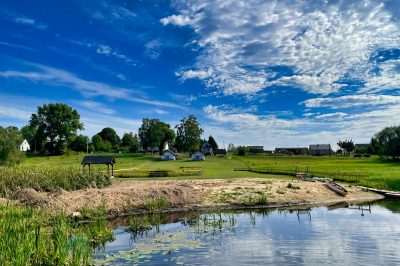Every year on the day of Jesus’ baptism, thousands of Orthodox Christians gather at lakes and rivers throughout Eastern Europe for ice bathing – a popular tradition that is not part of the official sacraments of the Orthodox churches, but is actively practiced. It is believed that the water is holy on that day and that anyone who jumps into the water will have their sins forgiven. The tradition has only really spread in recent decades, as the Soviet Union generally regarded the church and religion as the enemy or, in the words of Karl Marx, as “opium for the people”.

Every year, certain places are designated in Ukrainian, Belarusian and Russian cities that are suitable for ice bathing. Water rescuers, doctors and police are always present on site, as this is an event that is not without danger. Time and again there are fatalities, especially in places where, despite recommendations, people organize their own ice bathing at their own risk. And of course you can only go into the water sober. The deaths are isolated cases, but they could have been avoided.

At the so-called Sochelnik (evening of the January 18), everything has to be ready to go: The baptismal pool is drilled, the water quality is tested and changing rooms are set up. The church service takes place around 10 p.m. and the party can start immediately afterwards. Depending on the location, anyone who wants to can usually dive into the ice cold holy water until the evening of the January 19th. You go under water three times and cross yourself. Afterwards you get a cup of hot tea.
Ice bathing in other parts of Europe
The tradition is also practiced by the Orthodox in other parts of Europe – the St. Georg monastery in Götschendorf in Brandenburg offers annual bus trips from Berlin for all Orthodox who want to attend the service on the feast day and then go into the water. Even in Kazakhstan (a country dominated by islam), many people dive into the water on January 19th – despite warnings from imams that after ice bathing you are considered a baptized person. In Orthodox Armenia, however, this tradition is hardly practiced.
Ice bathing in Serbia
The approach in the Balkans is different. For 26 years, people (previously only men, but recently women have also been allowed to take part) have been gathering at the rivers and have to swim 33 meters – corresponding to the number of years of Jesus’ life – in the ice-cold water to a cross. The first person to touch the cross picks it up and brings it to the shore. The winner gets to keep the cross until the next baptism and is protected by God for the whole year – at least that’s what the Serbs believe.
The fastest swimmer in Odžaci in 2023 was Anja Jovović, a 20-year-old policewoman from the neighboring town of Ratkovo. Her 11-year-old brother Luka was the first to make it to the cross in 2019. Luka was the youngest swimmer at the time and died in 2022. When Anja came out of the water with the cross, she put on a T-shirt with a picture of her brother and the signature “Živiš!” (Serbian – you are alive!).
Ice bathing in Bulgaria
In Bulgaria, people bathe on January 7th, the so-called “Ivanovden” (John the Baptist Day). According to Bulgarian tradition, newlyweds in particular have to go into the water. The task of checking this is the responsibility of the godparents, who are supposed to push the couple into the water. They also bake a special bread on the occasion of Ivanovden.

Ice bathing in Batumi, Georgia
Since 2004, the festive winter bathing has also been held in Batumi, Georgia. As the city is located in the subtropics, snow and ice can only be found in the mountains. On the other hand, the Black Sea is warm and does not freeze. Here I came across the most beautiful christening tradition I have ever experienced. Shortly before midnight, the faithful gather in front of the Cathedral of the Nativity of the Virgin Mary and walk together with the priests through the city to the sea.

The neo-Gothic cathedral, built at the beginning of the 20th century, does not look like a classic Orthodox church – it was used as a Catholic place of worship until the beginning of the Soviet era. Under the Soviets, there were several attempts to destroy the cathedral, which led to protests in the city. The building remained, but was used for other purposes, including as an archive. It has served as an Orthodox cathedral since 1989 and is also the largest religious building in Batumi.

After all the participants have gathered on the beach and lit the candles, they pray – in Georgian. After the prayer, the priests go into the water first and then everyone else is allowed in.

The water in the Black Sea is warmer than in most other places where people bathe on the day of Jesus’ baptism. But the point is not that you have to freeze. Several campfires are also lit on the beach, which contributes to an already cozy and nice atmosphere.
How did you like our article about ice bathing on the day of Jesus’ baptism among the Orthodox? What other traditions would you like us to report on? Let us know and write us a comment! And here you can find my articles about the Augustów Canal and Russian rock music.



